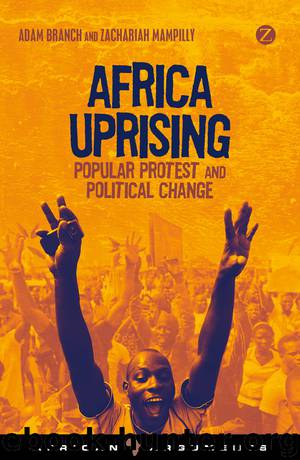Africa Uprising by Branch Adam Mampilly Zachariah

Author:Branch, Adam, Mampilly, Zachariah
Language: eng
Format: epub, mobi
Publisher: Zed Books
Published: 2015-06-08T16:00:00+00:00
7 | Protest and counter-protest in Ethiopia
‘2005 did not happen overnight,’ explained the former student activist, sipping strong coffee in the patio of an old downtown hotel, while a man who appeared to be a government informer sat at the next table, trying rather conspicuously to listen. ‘The election was just what set everything off; … the political parties picked up existing grievances and, for the first time, enabled people to see an alternative’ to the fourteen-year rule of Meles Zenawi and the Ethiopian People’s Revolutionary Democratic Front (EPRDF).1 With the release of results of the 2005 election declaring the EPRDF the winner, people reacted by taking to the streets in an explosion of popular politics, a mass urban uprising not seen since the 1974 Ethiopian revolution.
Although the protests took place immediately after the elections, it is important to note that, as in Uganda, they were not about the opposition’s loss. In fact, the protests represented a critique of the opposition political parties as much as of the state. Although the election outcome ignited the protests, they grew out of a broad set of social, economic, and political transformations that had culminated in 2005. These transformations led a wide array of primarily urban groups – professionals, workers, intellectuals and students, youth in and out of school, and the informal networks spanning political society – to accumulate a set of grievances against the EPRDF regime. The elections simply provided the opportunity for the emergence of dynamic public spheres where those grievances could be aired, discussed, and radicalized, for the activation of a broad mobilization among the population, and for a single issue to provide a focus and a demand around which the many groups could converge.
However, the informer’s presence during our 2013 interview made clear that the uprising had not brought about a new regime or even a meaningful reform. Instead, the protests were met with an onslaught of state violence, and then they ushered in an era of intensified, expansive repression and control. The most visible legacy of the protests today is found in the massive developmental works the EPRDF has undertaken in cities across the country, a tremendous, often violent, restructuring of urban Ethiopia. Visitors to Addis or the provincial capitals cannot miss the huge new construction projects, in particular the roads, office buildings, housing, and even a light rail system that has left gaping holes in the middle of Addis’s streets. The epitome of the government’s urban renovation is an immense donor-supported cobblestone project, which has used environmentally friendly techniques to pave roads in 140 towns, employing 90,000 young people (Broussard and Tsegay 2012). This transition from popular protest to authoritarian development – from nation-wide uprisings to the counter-protest state – is the subject of this chapter.
The rise and the crisis of the EPRDF
The EPRDF, a coalition with the Tigrayan People’s Revolutionary Front (TPLF) at its centre, took power in 1991 after almost two decades of rural armed struggle to end the repression of the Derg. The Derg,
Download
Africa Uprising by Branch Adam Mampilly Zachariah.mobi
This site does not store any files on its server. We only index and link to content provided by other sites. Please contact the content providers to delete copyright contents if any and email us, we'll remove relevant links or contents immediately.
The Secret History by Donna Tartt(16610)
The Social Justice Warrior Handbook by Lisa De Pasquale(11485)
Thirteen Reasons Why by Jay Asher(7782)
This Is How You Lose Her by Junot Diaz(5753)
Weapons of Math Destruction by Cathy O'Neil(5031)
Zero to One by Peter Thiel(4817)
The Myth of the Strong Leader by Archie Brown(4785)
Promise Me, Dad by Joe Biden(4440)
Stone's Rules by Roger Stone(4412)
Beartown by Fredrik Backman(4404)
How Democracies Die by Steven Levitsky & Daniel Ziblatt(4392)
The Fire Next Time by James Baldwin(4337)
100 Deadly Skills by Clint Emerson(4071)
A Higher Loyalty: Truth, Lies, and Leadership by James Comey(4026)
Rise and Kill First by Ronen Bergman(4008)
The David Icke Guide to the Global Conspiracy (and how to end it) by David Icke(3875)
The Farm by Tom Rob Smith(3869)
Secrecy World by Jake Bernstein(3773)
The Doomsday Machine by Daniel Ellsberg(3725)
